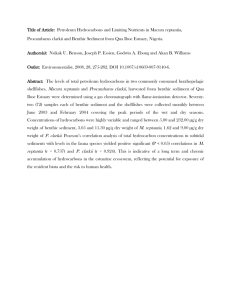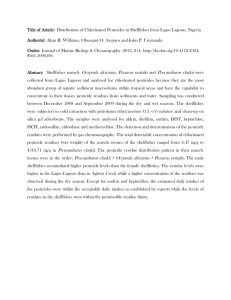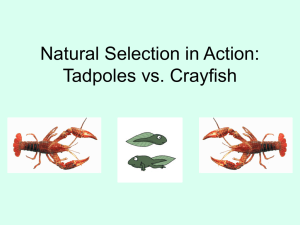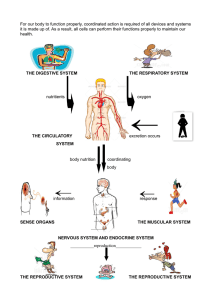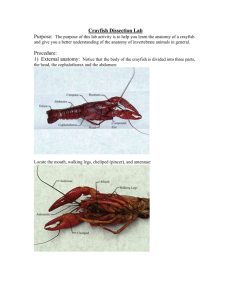Reproductive plasticity of a Procambarus clarkii population living 10
advertisement
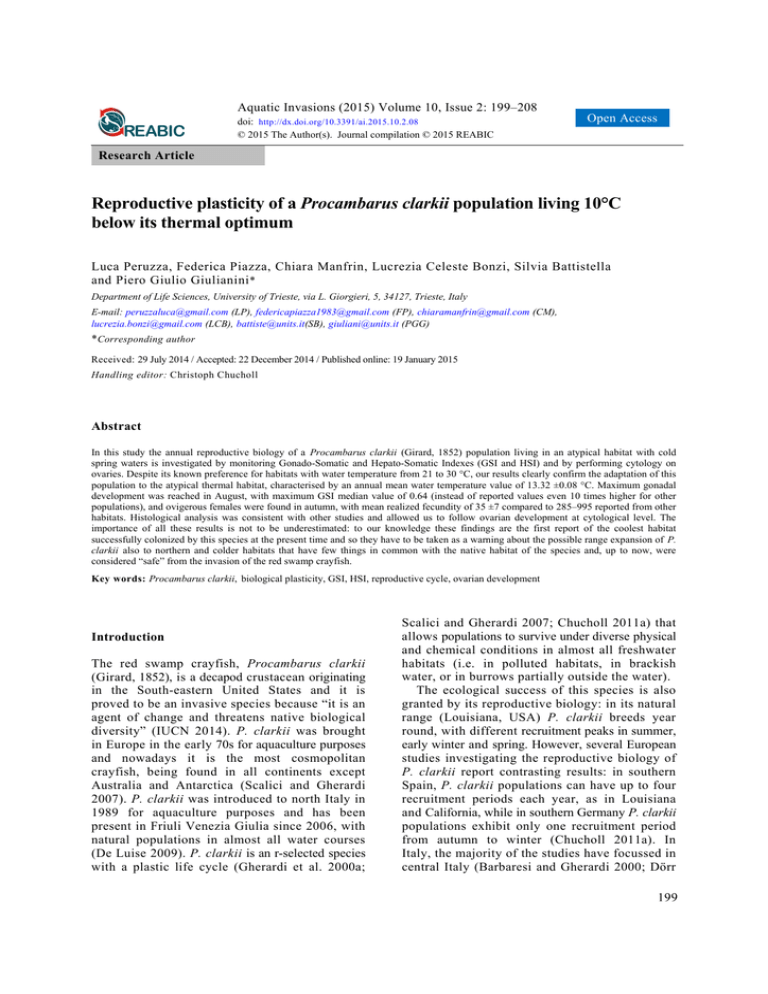
Aquatic Invasions (2015) Volume 10, Issue 2: 199–208 doi: http://dx.doi.org/10.3391/ai.2015.10.2.08 © 2015 The Author(s). Journal compilation © 2015 REABIC Open Access Research Article Reproductive plasticity of a Procambarus clarkii population living 10°C below its thermal optimum Luca Peruzza, Federica Piazza, Chiara Manfrin, Lucrezia Celeste Bonzi, Silvia Battistella and Piero Giulio Giulianini * Department of Life Sciences, University of Trieste, via L. Giorgieri, 5, 34127, Trieste, Italy E-mail: peruzzaluca@gmail.com (LP), federicapiazza1983@gmail.com (FP), chiaramanfrin@gmail.com (CM), lucrezia.bonzi@gmail.com (LCB), battiste@units.it(SB), giuliani@units.it (PGG) *Corresponding author Received: 29 July 2014 / Accepted: 22 December 2014 / Published online: 19 January 2015 Handling editor: Christoph Chucholl Abstract In this study the annual reproductive biology of a Procambarus clarkii (Girard, 1852) population living in an atypical habitat with cold spring waters is investigated by monitoring Gonado-Somatic and Hepato-Somatic Indexes (GSI and HSI) and by performing cytology on ovaries. Despite its known preference for habitats with water temperature from 21 to 30 °C, our results clearly confirm the adaptation of this population to the atypical thermal habitat, characterised by an annual mean water temperature value of 13.32 ±0.08 °C. Maximum gonadal development was reached in August, with maximum GSI median value of 0.64 (instead of reported values even 10 times higher for other populations), and ovigerous females were found in autumn, with mean realized fecundity of 35 ±7 compared to 285–995 reported from other habitats. Histological analysis was consistent with other studies and allowed us to follow ovarian development at cytological level. The importance of all these results is not to be underestimated: to our knowledge these findings are the first report of the coolest habitat successfully colonized by this species at the present time and so they have to be taken as a warning about the possible range expansion of P. clarkii also to northern and colder habitats that have few things in common with the native habitat of the species and, up to now, were considered “safe” from the invasion of the red swamp crayfish. Key words: Procambarus clarkii, biological plasticity, GSI, HSI, reproductive cycle, ovarian development Introduction The red swamp crayfish, Procambarus clarkii (Girard, 1852), is a decapod crustacean originating in the South-eastern United States and it is proved to be an invasive species because “it is an agent of change and threatens native biological diversity” (IUCN 2014). P. clarkii was brought in Europe in the early 70s for aquaculture purposes and nowadays it is the most cosmopolitan crayfish, being found in all continents except Australia and Antarctica (Scalici and Gherardi 2007). P. clarkii was introduced to north Italy in 1989 for aquaculture purposes and has been present in Friuli Venezia Giulia since 2006, with natural populations in almost all water courses (De Luise 2009). P. clarkii is an r-selected species with a plastic life cycle (Gherardi et al. 2000a; Scalici and Gherardi 2007; Chucholl 2011a) that allows populations to survive under diverse physical and chemical conditions in almost all freshwater habitats (i.e. in polluted habitats, in brackish water, or in burrows partially outside the water). The ecological success of this species is also granted by its reproductive biology: in its natural range (Louisiana, USA) P. clarkii breeds year round, with different recruitment peaks in summer, early winter and spring. However, several European studies investigating the reproductive biology of P. clarkii report contrasting results: in southern Spain, P. clarkii populations can have up to four recruitment periods each year, as in Louisiana and California, while in southern Germany P. clarkii populations exhibit only one recruitment period from autumn to winter (Chucholl 2011a). In Italy, the majority of the studies have focussed in central Italy (Barbaresi and Gherardi 2000; Dörr 199 L. Peruzza et al. et al. 2006; Gherardi 2006; Scalici and Gherardi 2007; Scalici et al. 2010) and Italian populations have a reproductive pattern that appears intermediate between the Spanish and German populations (Chucholl 2011a). To date, no study has investigated the reproductive biology of P. clarkii in north Italy, despite its presence in many watercourses. Analysis of freshwater crustacean populations living in Friuli Venezia Giulia (FVG, North-East Italy) during the Life RARITY Project (LIFE 10 NAT / IT / 000239) revealed the presence of P. clarkii living in channels with atypical water temperatures, near the Brancolo canal (Go, Italy) and inside the Brancolo reclamation area. In the light of this fact, a sampling site in one river within the reclamation area was chosen to investigate the population and the reproductive biology of this invasive species on yearly scale. The results may provide information allowing successful control and management of P. clarkii populations and can be compared to reproductive patterns in other populations. The Gonado-Somatic Index (GSI) and the Hepato-Somatic Index (HSI) were monitored during a single year and light microscopical and ultra-structural cytological assessments were performed on female crayfish ovaries following the different stages of the ovarian development (Kulkarni et al. 1991; Ando and Makioka 1998). Materials and methods Sampling area The selected population inhabited an artificial canal inside the “Bonifica del Brancolo” (“Brancolo's reclamation area”, 45°46'N, 13°30'E, GO, Italy). The first recorded occurrence of P. clarkii in the reclamation area “Bonifica del Brancolo” was in 2007. P. clarkii was introduced through use as live bait by local fishermen (De Luise 2009). The studied population is isolated: the sampling site is bordered by the Brancolo river to the north (which has salty and colder waters and where P. clarkii is not present), by the Adriatic Sea to the south and east, and by an extensive network of drainage canals to the west (with same water characteristics as in our site). The area is one meter below sea level. Various springs can be found on the riverbed of all water channels inside the reclamation area which is also subjected to tides. For these reasons the area comprises artificial canals linked to a series of de-watering pumps which remove excess water. 200 The de-watering pumps are typically operated for 20h/day during the summer, removing water at 800 l/sec, but can remove 5400 l/sec during heavy rainfall. Sampling activity Samples were collected over the period of one year beginning in March 2013, with a total of 24 sampling sessions (with the exception of the first two months, samples were collected every 15 days). Sampling was always conducted in the same 120-m stretch of the river, using 20 lobster pots baited with canned food left in the river bed for 48 h. On each occasion, water temperature (°C ±0.01) was determined with an outdoor thermometer data-logger (Tinytag Aquatic 2 TG4100, Gemini Data Loggers, Chichester UK) at least 24 hours before specimens were collected. The instrument recorded the temperature at the riverbed once every 10 minutes. Temperature data were used to control trend in the water temperature on a monthly scale. Salinity measurements (μS/cm ±1) were taken on several occasions using a conductivity probe Hanna HI 8633 (Hanna instruments, Woonsocket, RI). The probe was weighted to ensure salinity was measured at the riverbed. For every site, measurements were made three times. Captured crayfish were counted, sexed and their carapax total length (CTL) determined to a precision of ±0.1 mm. Pleopodal eggs or offspring were counted in ovigerous females to determine the realized fecundity of the studied population (FR) (Ma et al. 1998). The reproductive stage of captured males was determined according to Taketomi (Taketomi et al. 1996). Sexually mature males were staged E, on the basis of the presence of reversed spines on the third and fourth walking legs, while sexually immature males were collectively staged D (pooling Taketomi's A – D stages). The classification used by Taketomi et al. (1996) is based solely on secondary sexual characteristics (copulatory appendages and third and fourth pereiopods) and their relation with development of testis and androgenic gland. Although no correlation is present between Taketomi’s classification and the commonly used Form I and Form II classification, only Stage E males have the anatomical characteristics needed to successfully complete copulation. For each sampling date, 14 females with CTL between 44 and 70 mm were dissected after anaesthetization, and HSI (HSI= hepatopancreas wet weight / female total wet weight ×100) and Reproductive plasticity of Procambarus clarkii Figure 1. Trend in river bed water temperature in Brancolo's channel. Boxplot of 24h sampling. Bold line represents the mean annual water temperature value (13.32 ±0.08 °C). Circles beyond whiskers are outliers. GSI (GSI= ovary wet weight / female total wet weight *100) were determined and their ovaries were fixed for 24 h at room temperature in a modified SPAFG fixation solution (Ermak and Eakin 1976) (2.5% glutaraldehyde, 0.8% paraformaldehyde and 7.5% saturated aqueous solution of picric acid in 0.1 M phosphate buffered saline, pH 7.4, with 1.5% sucrose). Samples for optical microscopy were embedded in LR-White resin (London Resin Company, UK) after dehydration in ethanol (50%, 70%, 95% and absolute). Semithin sections (1–2μm) cut on a Pabisch TOP Ultra 150 (Pabish, Germany) were stained with toluidin blue. Samples used for TEM were postfixed in 1% osmium tetroxide, dehydrated in ethanol and embedded via propylene oxide in Epon 812-Araldite mixture (Electron Microscopy Sciences, USA). Sections on 200-300 mesh nickel grids were stained with uranyl acetate and lead citrate and viewed under a Philips EM 208 TEM (Philips) at 100 kV. Data are expressed as data ± SEM. Statistical analysis were performed using R software version 3.0.1 RC 2014, while histological measures on samples were performed using ImageJ software (ver. 1.48b) (Schneider et al. 2012). Statistically significant differences refer to p-value <0.05. Ethical note The experiments comply with the current laws of Italy, the country in which they were done. No specific permits were required for the studies that did not involve endangered or protected species. Individuals were maintained in appropriate laboratory conditions to guarantee their welfare and responsiveness. After the experiments were completed, crayfish were sacrificed by hypothermia. Results Monitoring activity Trend in the water temperature over the year on the sampling site is shown in Figure 1. Because of the cold spring waters, temperatures recorded at the riverbed are always low and only a relatively small thermal deviation is evident across different seasons. Mean values over the 24 h period range from 8.65 ±0.08 °C to 16.19 ±0.12 °C, around an annual mean value of 13.32 ±0.08 °C. The minimum water temperature value of 7.16 °C has been recorded in December 2013. During the summer, while mean air temperature can reach 27.9 °C (Aeronautica Militare, climatic 201 L. Peruzza et al. Figure 2. Abundance of male and female Procambarus clarkii captured during the monitoring activity of the population in Brancolo's channel. Distances between adjacent dates on the X-axis are proportional to the number of days between them. tables http://clima.meteoam.it/AtlanteClimatico/pdf/ %28110%29Trieste.pdf), mean water temperature remained below 19 °C (with maximum mean water temperatures over 24 h periods of 16.17 ±0.08 °C in November 2013 and maximum water temperature of 19.13 °C in June 2013). Salinity measurements report oscillations between a minimum of 732 μS/cm and a maximum of 1770 μS/cm, with a mean conductivity of 1128 ±48 μS/cm. Tidal cycle, de-watering pump activity, spring water and precipitation are the main factors responsible for the difference between the conductivity values recorded. From March 2013 a total of 24 sampling campaigns were done. A total of 3090 animals were captured, with an overall sex ratio of 1:1.15 (F:M). Relative abundance of male and female crayfish for every sampling date is showed in Figure 2. From June to December captured males are always more abundant than females, ultimately reaching a maximum sex ratio of 2.85:1 on 5 September. From January the situation is reversed and females reach a maximum sex ratio of 1.55:1 on 7 March 2014. The shortest animal captured is 19.5 mm CTL, and the longest is 77.1 mm CTL; mean CTL of males and females are 48.94 ±0.23 mm and 49.89 ±0.23 mm respectively. The reproductive stage of captured males is shown in Figure 3. Males with a fully developed copulatory organ (with CTL ranging from 26.60 mm to 71.90 mm, mean 50.31 ±0.40 mm) are 202 present at maximum abundances during the summer period, with their abundance decreasing until the following spring. GSI and HSI values obtained from females during the monitoring activity are shown in Figure 4. The mean GSI value across the year is 0.38 ±0.02 (bold line, Figure 4A) with a minimum value of 0.04 recorded on 19th November 2013, and a maximum of 4.24 recorded on 9th April 2014. The maximum median GSI (0.64) is reached during summer, on 7th August. Only 4 medians out of 24 (from July to September) are found above the mean GSI value. Over the same period inter-individual variability was high (Figure 4A). Pairwise comparisons of GSI among dates using Wilcoxon rank sum test with Bonferroni's correction (data not presented) reveals that GSI on 7th August is statistically different from 10 (of 23) other sampling dates. GSI on 22nd August and 4th December is statistically different from 4 other dates each. The mean HSI value across the year is 7.46 ±0.07 (bold line, Figure 4B) with a minimum value of 3.56 recorded on 9th April 2014, and a maximum value of 10.70 recorded on 7th March 2014. High inter-individual variability is found across all sampling dates. In general, median HSI values tend to rise until the beginning of June before decreasing during the summer period, reaching the minimum median HSI value of 5.67 Reproductive plasticity of Procambarus clarkii Figure 3. Reproductive stage (according to Taketomi et al. 1996) of captured males. See text for morphological distinction between Stage D and Stage E. Distances between adjacent dates on the X-axis are proportional to the number of days between them. Figure 4. Box-plot of GonadoSomatic (A) and HepatoSomatic (B) indexes from captured female crayfish sampled in Brancolo's channel. The bold line represents the annual mean GSI and HSI (respectively 0.38 ± 0.02 and 7.46 ± 0.07). Circles beyond whiskers are outliers. Distances between adjacent dates on the Xaxis are proportional to the number of days between them. 203 L. Peruzza et al. Figure 5. Optical microscopy images of ovaries dissected from females sampled in Brancolo's channel. A: Section of immature ovary showing some Germinaria (arrow). B, C, D, E: Section of different ovaries at increasing ovarian development, showing the gradual storage of yolk granules (arrow) in the oocyte's ooplasm. Note the increase in dimensions of these granules resulting from merging events. F: Section of an ovary after spawning, showing a large central portion without oocytes with residual post-ovulatory follicles in the ovarian lumen. Scale bar: 500 μm for micrographs B, C, D and E, and 250 μm for micrographs A and F. in October, and then gradually rising again. Pairwise comparisons among dates using Wilcoxon rank sum test with Bonferroni's correction indicates that HSI on 10th October, when the lowest HSI values were collected, is statistically different from 8 other sampling dates. From the end of September to the beginning of February a total of 30 ovigerous females were captured, 13 of them with eggs in different developmental stages and 17 of them with offspring still attached to the pleopods. The mean realized fecundity was 35 ±7 eggs/female. The smallest ovigerous female captured was 39.50 mm CTL, while the largest was 63.30 mm CTL; the mean CTL for ovigerous females was 53.29 ±0.99 mm. Histological analysis Histological analysis has been performed to describe the reproductive biology of the species in this atypical habitat. Histological specimens have been classified according to the classification scheme given by Kulkarni (Kulkarni et al. 1991). 204 The most immature ovary observed is between Stage 3 – Avitellogenic and Stage 4 – Early Vitellogenic (Figure 5A). The mean oocyte diameter is 196.3 μm ±78.2 (n=9) with a mean nuclear diameter of 47.5 μm ±19.3 (n=7). The nucleus is centrally located, with a circular shape and usually 4 nucleoli of 1.9 μm2 ±0.5 (n=30) are present immediately beneath the nuclear membrane. The ooplasm is homogeneous, without yolk granules. A 4.7μm ±1.1 thick layer of flat follicle cells is present around the oocyte membrane, creating the oogenetic pouch. Oocytes in Early Vitellogenic (Kulkarni et al. 1991) phase exhibit a mean diameter of 232.1 μm ± 77.3 (n=18) with a nuclear diameter of 57.2 μm ±17.8 (n=8). Up to five nucleoli are present immediately under the nuclear membrane. During this phase, in the ooplasm, some small yolk granules (maximum diameter < 4 μm) start storing in the perinuclear area (Figure 5B). Early during secondary vitellogenesis, mean oocytes diameter is 361.4 μm ±79.6 (n=12), nuclear diameter is 60.2 μm ±17.1 (n=4) and about 6 nucleoli are present adjacent to the nuclear membrane. Reproductive plasticity of Procambarus clarkii Figure 6. Electron microscopical images of the germinative portion in the ovary, known as Germinarium. A: 1100x micrograph showing 3 oogonia (O) with a large, euchromatic nucleus and several follicular cells (FC) next to them. Follicular cells arranged to form an oogenetic pouch with an oocyte are found outside the Germinarium. B, C: 2800x micrograph showing 2 oogonia at an early stage of development with a nucleus (N) which can account for as much as 66% of the area of the cell, in section. In the ooplasm some small mitochondria with shelf-like and tubular cristae (m) can be seen. D: 2200x micrograph of an oogonium at a more mature stage with greater ooplasm area, in section, and surrounded by some follicular cells. Immediately below the cell membrane small yolk granules of 5.9 μm ±1.3 (n=55) are homogeneously stored in the ooplasm (Figure 5C). During development, oocytes gradually increased their size, reaching a mean diameter of 420.6 μm ±116.8 (n=9); the nuclear mean diameter is 71.0 μm ±18.7 (n=4) and 4 nucleoli are usually present. Oocytes tend to lose their round shape in cross sections and appear squarer. In the ooplasm yolk granules have increased in number (but not their size, 5.3 μm ±1.1, n=55) and are interposed between lipid droplets which appear as white vesicles (Figure 5D). When oogenesis is almost complete, oocytes reach a mean diameter of 852.3 μm ±179.4 (n=5); yolk granules and lipid droplets occupy the majority of the cell, with ooplasm reduced to a narrow band surrounding the nucleus. In this stage of oogenesis, yolk granules have a diameter ranging from 17 to 83 μm, due to merging events where small numerous granules become a single bigger one (Figure 5E). In post-ovulatory ovaries, some oocytes at various developmental stages are still present in the ovary even when empty spaces (left by laid oocytes) appear and large zones consisting only of ovarian epithelium, follicle cells and hemocytes are visible. Follicle cells no longer associated with an oocyte appear small and circular and are patchily distributed in the ovarian lumen (Figure 5F). Atretic oocytes, surrounded by follicular cells can be found; these auxiliary cells appear thicker (up to 20 μm) because of the uptake of yolk granules and lipid droplets from apoptotic oocyte's ooplasm. Ultra-structure of the germinative portion of the ovary is shown in Figure 6. This region of the ovary is essentially composed by oogonia, follicular cells and some previtellogenic oocytes. Although still immature, oogonia are always surrounded by one or more follicular cells which will later expand and create a monolayer of epithelial cells, the so-called oogenetic pouch. In cross sections oogonia exhibit different forms, ranging from polygonal to elliptical; during development oogonia increase in dimensions (oogonia shown have diameters from 14 to 28 μm), with a large and circular euchromatic 205 L. Peruzza et al. nucleus that account for as much as 66% of the area of the cell, in section. The ooplasm appears heterogeneous with numerous small mitochondria present (mean diameter 474.62 nm ±43.65; n=17). In addition, some mitochondria with shelf-like and tubular cristae can be seen. Follicular cells have an irregular shape that in the majority of the cases is elongated, embracing the oocyte. Follicular cells have a minimum thickness of 0.88 μm and a maximum thickness of 4.36 μm in the region of the nucleus. The nucleus is heterochromatic and its shape resembles that of the cell. Discussion Monitoring activity While the overall sex ratio of the population is 1:1, it is interesting that from June to November males were always more abundant than females, whilst the situation was reversed from December to May, splitting the year in two periods where one of the sexes is more active than the other. In general, males are active during the reproductive season (driven by the search for a sexually mature female) which lies in the summer, while females are more active during winter-spring, as they need to feed more to accumulate energy in the hepatopancreas. It is noteworthy that there was no difficulty in capturing specimens during the winter, in contrast to observations made on other populations. In fact in north-eastern Italy (Vicenza, author’s observations) and as reported in one case in central Italy, in rivers or lakes with a large seasonal difference in water temperature no captures are made during winter sampling because crayfish are inhibited by low temperatures (Dörr et al. 2006; Dörr and Scalici 2013). The same inhibitory pattern has been found in southern Germany in lentic habitats with large thermal variability, with traps deployed for up to two weeks during winter sampling (Chucholl 2011a; Chucholl 2011b). High variability in the size of reproductive males is confirmed by our data; the range in CTL size of stage E males (from 26.60 to 71.90 mm) is almost equal to the range of the entire sampled male population (ranging from 19.50 to 75.10 mm) in our study area. Mature males are therefore always present in the habitat, although with different percentages across the seasons. The constant 100% percentage of stage E males during summer indicates that reproduction occurs during this season and may extend to the end of October (when more than 60% males were 206 still in stage E). Similar patterns have been reported for southern Germany (Chucholl 2011a), but different patterns are reported for central Italy (Gherardi et al. 2000b; Scalici and Gherardi 2007) and for Spain (Anastácio and Marques 1995): waters are warmer during the spring both in central Italy and in Spain than in southern Germany or in our study area, allowing southern populations to begin their reproductive cycle in April, i.e. 2 to 3 months earlier than in northern populations. Moreover, the greater abundance of males than females during the summer is consistent with the beginning of the reproductive period; in fact, sexually mature males are more active during the reproductive period because they are driven by the search for a mate and they can cover long distances (Gherardi and Barbaresi 2000). On the other side, the continuing presence of stage E males during winter may be explained by the atypical water characteristics, particularly the low degree of thermal variability: in fact, the annual mean water temperature is 13.32 ±0.08 °C with few thermal excursions during the year and median temperature is seldom more than 3 °C far from the mean temperature. In the light of this, the presence of P. clarkii in rivers with such a thermal regime is quite unusual; indeed many researches have underlined that this species has a strong preference for temperatures ranging from 21 °C to 30 °C, with an optimum at 23.5 °C (Espina et al. 1993; Bückle Ramírez et al. 1994; Huner and Holdich 2002; Lagerspetz and Vainio 2006). Even the populations studied in Germany are found in habitats with lentic waters that can reach 20 °C during the summer (Chucholl 2011b; Chucholl 2011a). In contrast, the Brancolo population never experiences such high water temperatures even during summer period, because of the continuous input of cold water in the channel that restricts warming. Further, there was no inhibition of crayfish activity during winter (no decrease in number of specimens captured with the same catch per unit effort, Figure 2) despite winter mean temperatures of 8.65 °C, 10.81 °C, 8.92 °C and 11.80 °C. In our sampling area mean salinity was 1g/L and does not appear to be a limiting factor for these animals (both in terms of growth and reproduction). This is consistent with previous reports by Huner and Barr and Meineri et al., who reported that reproduction is restricted to water less than 5g/L salinity (Huner and Barr 1991; Meineri et al. 2014). Reproductive plasticity of Procambarus clarkii The studied population presents low GSI values across all the year, with a mean value of 0.38 ±0.02 (bold line, Figure 4A), while in other habitats P. clarkii can reach GSI values of 8 (Alcorlo et al. 2008) with annual mean values near 1 (Chucholl 2011a). In our study area, the highest GSI median values have been recorded between July and September, reaching a maximum median value of 0.64 (7 August). The statistically greater GSI in August compared with 14 (of 23) other sampling dates indicates that maximum gonadal development is reached in August in this population, although GSI values for mature females remain far below those reported in the literature. Indeed, in contrast from what reported in literature (Niquette and d’ Abramo 1991; Daniels et al. 1994) temperature does not appear to be the overriding factor that regulates whether or not ovarian development proceeds or, in other words, in this population, the threshold temperature is lower than for other populations reported; in fact, also with mean water temperatures between 14 and 17 °C, ovarian development is active and ovigerous females appear later in September. CTL values from ovigerous females ranged between 39.50 and 63.30 mm, comprising almost half the CTL range of the female population (from 21.00 to 77.10 mm). Chucholl (2011a) reported a narrower CTL range of ovigerous females (from 44.9 to 56.1 mm) in comparison with the population of the present study, where females up to 10 mm (CTL) smaller can be reproductive. The realized fecundity of 35 ±7 eggs per female is extremely low in comparison with the reported values of 285 in Germany (Chucholl 2011a), 313 in Louisiana (Penn Jr 1943), 433 in Kenya (Oluoch 1990) and 995 in Spain (Alcorlo et al. 2008). It is likely that the atypical low temperatures experienced by this population, far below from the optimum for the species, stress the animals restricting allocation of energy to reproduction, resulting in extremely low GSI and fecundity values. Histological analysis Histological analysis was performed to describe the reproductive biology of the species in this atypical habitat by following ovarian development through different stages, across a whole year. Classifications for ovarian development of P. clarkii are based on ovarian macroscopic characteristics (Romaire and Lutz 1989), or on histological ones (Kulkarni et al. 1991). It is noteworthy that also fully developed oocytes (as the one presented in Figure 5E, dissected in August) have been always found in ovaries with a low GSI (Figure 4A) that in only 1.86% of total values is above the value of 1.75 and in none is above 4.2. Observations made using both macroscopic and histological characteristics confirm the reproductive activity of P. clarkii in Brancolo's channel: all ovarian stages from the Romaire and Lutz (1989) system have been found based on ovary colour and aspect, but not on GSI. Indeed, black ovaries (fully developed) from our specimens had a GSI value ranging from 0.16 to 4.24, instead of the reported range of 2.3 to 8. Taken together, these observations indicate that the population living in Brancolo's channel is able to complete its reproductive cycle, but also that females are unable to support development of a high number of oocytes, yielding the low GSI and fecundity values recorded. Conclusion In conclusion, from the monitoring activity it has been shown that the population living in Brancolo’s channel has unique biological characteristics, being able to complete its life cycle at temperatures that, according to other studies, should curtail growth (Chucholl 2011a) and inhibit reproduction (Niquette and d’ Abramo 1991). In fact, abundance data, male reproductive stage and histological analysis data confirm these conclusions that could be seen collectively as the greatest example of biological plasticity of this species. The importance of all these results is not to be underestimated: they have to be taken as a warning about the possible range expansion of P. clarkii also to northern and colder habitats that have few things in common with the native habitat of the species and, up to now, were considered “safe” from the invasion of the red swamp crayfish. Acknowledgements Monitoring activity was financed by the RARITY Project (LIFE 10NAT/IT/000239) and was a cooperation between the Department of Life Science, University of Trieste and Ente Tutela Pesca, FVG. We are extremely grateful to Massimo Zanetti, Marco Presello, Romero Iacuzzo and Renzo Zanel (ETP) for all sampling activity, to Claudio Gamboz (University of Trieste) for TEM support and to Alastair Brown for the linguistic support. We would finally thank the reviewers who helped improving the manuscript. 207 L. Peruzza et al. References Alcorlo P, Geiger W, Otero M (2008) Reproductive biology and life cycle of the invasive crayfish Procambarus clarkii (Crustacea: Decapoda) in diverse aquatic habitats of SouthWestern Spain: Implications for population control. Fundamental and Applied Limnology/Archiv für Hydrobiologie 173:197–212, http://dx.doi.org/10.1127/1863-9135/2008/0173-0197 Anastácio P, Marques J (1995) Population biology and production of the red swamp crayfish Procambarus clarkii (Girard) in the lower Mondego river valley, Portugal. Journal of Crustacean Biology 15: 156–168, http://dx.doi.org/10.2307/1549018 Ando H, Makioka T (1998) Structure of the Ovary and Mode of Oogenesis in a Freshwater Crayfish, Procambarus clarkii (Girard). Zoological Science 15: 893–901, http://dx.doi.org/10. 2108/zsj.15.893 Barbaresi S, Gherardi F (2000) The Invasion of the Alien Crayfish Procambarus clarkii in Europe, with Particular Reference to Italy. Biological Invasions 2: 259–264, http://dx.doi.org/10.1023/A:1010009701606 Bückle Ramírez LF, Diaz Herrera F, Correa Sandoval F, et al. (1994) Diel thermoregulation of the crawfish Procambarus Clarkii (Crustacea, Cambaridae). Journal of Thermal Biology 19: 419–422, http://dx.doi.org/10.1016/0306-4565(94)90041-8 Chucholl C (2011a) Population ecology of an alien “warm water” crayfish (Procambarus clarkii) in a new cold habitat. Knowledge and Management of Aquatic Ecosystems 29, http://dx.doi.org/10.1051/kmae/2011053 Chucholl C (2011b) Disjunct distribution pattern of Procambarus clarkii (Crustacea, Decapoda, Astacida, Cambaridae) in an artificial lake system in Southwestern Germany. Aquatic Invasions 6: 109–113, http://dx.doi.org/10.3391/ai.2011.6.1.14 Daniels WH, D’Abramo LR, Graves KF (1994) Ovarian Development of Female Red Swamp Crayfish (Procambarus clarkii) as Influenced by Temperature and Photoperiod. Journal of Crustacean Biology 14: 530, http://dx.doi.org/10.23 07/1548999 Dörr AJM, La Porta G, Pedicillo G, Lorenzoni M (2006) Biology of Procambarus clarkii (GIRARD, 1852) in lake Trasimeno. Bulletin Français de la Pêche et de la Pisciculture 380–381: 1155–1168, http://dx.doi.org/10.1051/kmae:2006018 Dörr AJM, Scalici M (2013) Revisiting reproduction and population structure and dynamics of Procambarus clarkii eight years after its introduction into Lake Trasimeno (Central Italy). Knowledge and Management of Aquatic Ecosystems 408, 10, http://dx.doi.org/10.1051/kmae/2013045 Ermak TH, Eakin RM (1976) Fine structure of the cerebral and pygidial ocelli in Chone ecaudata (polychaeta: sabellidae). Journal of Ultrastructure Research 54: 243–260, http://dx.doi.org/10.1016/S0022-5320(76)80154-2 Espina S, Diaz Herrera F, Bückle RLF (1993) Preferred and avoided temperatures in the crawfish Procambarus clarkii (Decapoda, Cambaridae). Journal of Thermal Biology 18: 35–39, http://dx.doi.org/10.1016/0306-4565(93)90039-V Gherardi F (2006) Crayfish invading Europe: the case study of Procambarus clarkii. Marine and Freshwater Behaviour and Physiology 39: 175–191, http://dx.doi.org/10.1080/102362406008 69702 Gherardi F, Barbaresi S (2000) Invasive crayfish: activity patterns of Procambarus clarkii in the rice fields of the Lower Guadalquivir (Spain). Archiv für Hydrobiologie 150: 153–168 Gherardi F, Barbaresi S, Salvi G (2000a) Spatial and temporal patterns in the movement of Procambarus clarkii, an invasive crayfish. Aquatic Sciences 62: 179–193 Gherardi F, Raddi A, Barbaresi S, Salvi G (2000b) Life history patterns of the red swamp crayfish, Procambarus clarkii, in an irrigation ditch in Tuscany, Italy. Crustacean Issues 12: 99–108 208 Huner JV, Barr JE (1991) Red swamp crawfish: biology and exploitation: Louisiana State University. Center for Wetland Resources, Louisiana Sea Grant College Program, Baton Rouge, LA Huner JV, Holdich DM (2002) Procambarus. Biology of Freshwater Crayfish 541–584 IUCN (2014) The IUCN Red List of Threatened Species. Version 2014.2 Kulkarni GK, Glade L, Fingerman M (1991) Oogenesis and effects of neuroendocrine tissues on in vitro synthesis of protein by the ovary of the red swamp crayfish Procambarus clarkii (Girard). Journal of Crustacean Biology 11(4): 513– 522, http://dx.doi.org/10.2307/1548520 Lagerspetz KYH, Vainio LA (2006) Thermal behaviour of crustaceans. Biological Reviews 81: 237–258, http://dx.doi.org/10.1 017/S1464793105006998 Luise G De (2009) Studio preliminare sulla presenza del gambero rosso della Louisiana in Friuli Venezia Giulia. Ente Tutela Pesca - Friuli Venezia Giulia, http://www.entetutelapesca.it/ images/pdf/studi_ricerche/gambero_rosso_2009.pdf Ma Y, Kjesbu OS, Jłrgensen T (1998) Effects of ration on the maturation and fecundity in captive Atlantic herring (Clupea harengus). Canadian Journal of Fisheries and Aquatic Sciences 55: 900–908, http://dx.doi.org/10.1139/f97-305 Meineri E, Rodriguez-Perez H, Hilaire S, Mesleard F (2014) Distribution and reproduction of Procambarus clarkii in relation to water management, salinity and habitat type in the Camargue. Aquatic Conservation: Marine and Freshwater Ecosystems 24: 312–323, http://dx.doi.org/10.1002/aqc.2410 Niquette DJ, d’ Abramo LR (1991) Population dinamics of red swamp crawfish, Procambarus clarkii (Girard, 1852) and white river crawfish, P. acutus acutus (Girard, 1852), cultured in earthen ponds. Journal of Shellfish Research, Maine 10: 179–186 Oluoch AO (1990) Breeding biology of the Louisiana red swamp crayfish Procambarus clarkii Girard in Lake Naivasha, Kenya. Hydrobiologia 208: 85–92, http://dx.doi.org/10.1007/ BF00008447 Penn Jr GH (1943) A study of the life history of the Louisiana red-crawfish, Cambarus clarkii Girard. Ecology 24: 1–18, http://dx.doi.org/10.2307/1929856 Romaire RP, Lutz CG (1989) Population dynamics of Procambarus clarkii (Girard) and Procambarus acutus acutus (Girard) (Decapoda: Cambaridae) in commercial ponds. Aquaculture 81: 253–274, http://dx.doi.org/10.1016/00448486(89)90151-8 Scalici M, Chiesa S, Scuderi S, et al. (2010) Population structure and dynamics of Procambarus clarkii (Girard, 1852) in a Mediterranean brackish wetland (Central Italy). Biological Invasions 12: 1415–1425, http://dx.doi.org/10.1007/s10530-0099557-6 Scalici M, Gherardi F (2007) Structure and dynamics of an invasive population of the red swamp crayfish (Procambarus clarkii) in a Mediterranean wetland. Hydrobiologia 583: 309–319, http://dx.doi.org/10.1007/s10750-007-0615-8 Schneider CA, Rasband WS, Eliceiri KW (2012) NIH Image to ImageJ: 25 years of image analysis. Nature Methods 9: 671– 675, http://dx.doi.org/10.1038/nmeth.2089 Taketomi Y, Nishikawa S, Koga S (1996) Testis and Androgenic Gland during Development of External Sexual Characteristics of the Crayfish Procambarus clarkii. Journal of Crustacean Biology 16: 24, http://dx.doi.org/10.2307/1548927
